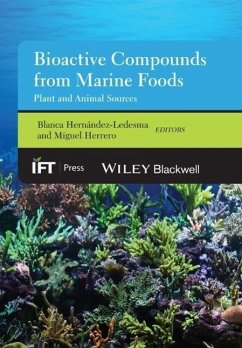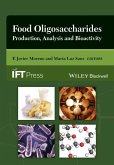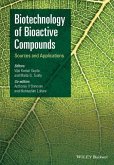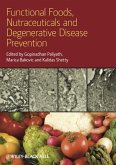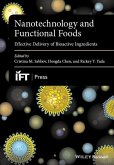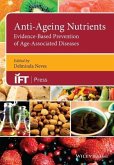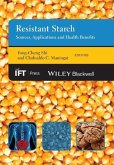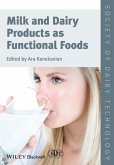Bioactive Compounds from Marine Foods
Plant and Animal Sources
Herausgegeben von Hernández-Ledesma, Blanca; Herrero, Miguel
Bioactive Compounds from Marine Foods
Plant and Animal Sources
Herausgegeben von Hernández-Ledesma, Blanca; Herrero, Miguel
- Gebundenes Buch
- Merkliste
- Auf die Merkliste
- Bewerten Bewerten
- Teilen
- Produkt teilen
- Produkterinnerung
- Produkterinnerung
Part of the IFT Press series, this book reviews the myriad published information on bioactive components derived from marine foods, enabling researchers and product developers to select appropriate functional ingredients for new products.
Chapters cover foods and food ingredients from both animal and plant marine sources, focusing on those which demonstrate biological properties and whose constituent compounds have been isolated and identified as potentially active. This book further addresses the biological activities of PUFAs (Polyunsaturated fatty acids), oils, phospholipids, proteins…mehr
Andere Kunden interessierten sich auch für
![Food Oligosaccharides Food Oligosaccharides]() Food Oligosaccharides290,99 €
Food Oligosaccharides290,99 €![Biotechnology of Bioactive Compounds Biotechnology of Bioactive Compounds]() Biotechnology of Bioactive Compounds348,99 €
Biotechnology of Bioactive Compounds348,99 €![Functional Foods, Nutraceuticals, and Degenerative Disease Prevention Functional Foods, Nutraceuticals, and Degenerative Disease Prevention]() Functional Foods, Nutraceuticals, and Degenerative Disease Prevention282,99 €
Functional Foods, Nutraceuticals, and Degenerative Disease Prevention282,99 €![Nanotechnology and Functional Foods Nanotechnology and Functional Foods]() Nanotechnology and Functional Foods244,99 €
Nanotechnology and Functional Foods244,99 €![Anti-Ageing Nutrients Anti-Ageing Nutrients]() Anti-Ageing Nutrients246,99 €
Anti-Ageing Nutrients246,99 €![Resistant Starch Resistant Starch]() Resistant Starch260,99 €
Resistant Starch260,99 €![Milk and Dairy Products as Functional Foods Milk and Dairy Products as Functional Foods]() Milk and Dairy Products as Functional Foods252,99 €
Milk and Dairy Products as Functional Foods252,99 €-
-
-
Part of the IFT Press series, this book reviews the myriad published information on bioactive components derived from marine foods, enabling researchers and product developers to select appropriate functional ingredients for new products.
Chapters cover foods and food ingredients from both animal and plant marine sources, focusing on those which demonstrate biological properties and whose constituent compounds have been isolated and identified as potentially active. This book further addresses the biological activities of PUFAs (Polyunsaturated fatty acids), oils, phospholipids, proteins and peptides, fibres, carbohydrates, chitosans, vitamins and minerals, fucoxantin, polyphenols, phytosterols, taurine, amongst others. These components, found in a variety of marine-derived foods, have been demonstrated to have preventative properties with regard to hypertension, oxidative stress, inflammation, cardiovascular diseases, cancer and other human diseases. Extraction methods and analysis techniques are also addressed. Intended for food scientists, food technologists and food engineers in academia, industry and government, this book reviews the substantial quantity of current research in this fast-moving and commercially valuable sector of food and nutrition science.
Hinweis: Dieser Artikel kann nur an eine deutsche Lieferadresse ausgeliefert werden.
Chapters cover foods and food ingredients from both animal and plant marine sources, focusing on those which demonstrate biological properties and whose constituent compounds have been isolated and identified as potentially active. This book further addresses the biological activities of PUFAs (Polyunsaturated fatty acids), oils, phospholipids, proteins and peptides, fibres, carbohydrates, chitosans, vitamins and minerals, fucoxantin, polyphenols, phytosterols, taurine, amongst others. These components, found in a variety of marine-derived foods, have been demonstrated to have preventative properties with regard to hypertension, oxidative stress, inflammation, cardiovascular diseases, cancer and other human diseases. Extraction methods and analysis techniques are also addressed. Intended for food scientists, food technologists and food engineers in academia, industry and government, this book reviews the substantial quantity of current research in this fast-moving and commercially valuable sector of food and nutrition science.
Hinweis: Dieser Artikel kann nur an eine deutsche Lieferadresse ausgeliefert werden.
Produktdetails
- Produktdetails
- Institute of Food Technologists Series
- Verlag: Wiley & Sons
- 1. Auflage
- Seitenzahl: 464
- Erscheinungstermin: 31. Dezember 2013
- Englisch
- Abmessung: 246mm x 173mm x 25mm
- Gewicht: 1723g
- ISBN-13: 9781118412848
- ISBN-10: 1118412842
- Artikelnr.: 39764862
- Herstellerkennzeichnung
- Libri GmbH
- Europaallee 1
- 36244 Bad Hersfeld
- gpsr@libri.de
- Institute of Food Technologists Series
- Verlag: Wiley & Sons
- 1. Auflage
- Seitenzahl: 464
- Erscheinungstermin: 31. Dezember 2013
- Englisch
- Abmessung: 246mm x 173mm x 25mm
- Gewicht: 1723g
- ISBN-13: 9781118412848
- ISBN-10: 1118412842
- Artikelnr.: 39764862
- Herstellerkennzeichnung
- Libri GmbH
- Europaallee 1
- 36244 Bad Hersfeld
- gpsr@libri.de
About the editors Dr Blanca Hernández-Ledesma Institute of Food Science Research (CIAL, CSIC-UAM), Madrid, Spain Dr Miguel Herrero Institute of Food Science Research (CIAL, CSIC-UAM), Madrid, Spain
List of Contributors xvii 1 An Update on the Biomedical Prospects of Marine-derived Small Molecules with Fascinating Atom and Stereochemical Diversity 1 Yvette Mimieux Vaske and Phillip Crews 1.1 Introduction 1 1.2 A view based on atom diversity 11 1.3 A view based on stereochemical diversity 15 1.4 Case studies of chemical probes and chemical probes in the therapeutic discovery pipeline 20 1.5 Conclusion 21 Acknowledgments 21 References 21 2 Antihypertensive Peptides from Marine Sources 27 Roseanne Norris, P
adraig
ýn A. Harnedy, and Richard J. FitzGerald 2.1 Introduction 27 2.2 Marine antihypertensive peptides and blood pressure control 28 2.3 Generation of marine antihypertensive peptides 32 2.4 Structure-activity relationships 32 2.5 Bioavailability 33 2.6 In vivo animal studies 35 2.7 In vivo human studies 41 2.8 Marine peptides as antihypertensive ingredients 45 2.9 Conclusion 48 Acknowledgments 48 References 48 3 Bioactive Peptides from Marine Processing Byproducts 57 Maria Hayes and David Flower 3.1 Introduction 57 3.2 Fish muscle proteins: precursors of fish bioactive peptides 58 3.3 Fish meal production 59 3.4 Fish silage production 59 3.5 Traditional fermented fish protein products 60 3.6 Strategies for the generation of bioactive peptides from marine byproducts 60 3.7 Conclusion 66 Acknowledgments 67 References 67 4 Development of Marine Peptides as Anticancer Agents 73 Xiukun Lin and Lanhong Zheng 4.1 Introduction 73 4.2 Peptides that induce apoptosis 73 4.3 Peptides that affect the tubulin-microtubule equilibrium 81 4.4 Peptides that inhibit angiogenesis 83 4.5 Peptides without a known mechanism for their antitumor activity 84 4.6 Conclusion 85 Acknowledgments 86 References 86 5 Using Marine Cryptides against Metabolic Syndrome 95 Yesmine Ben Henda and St
ephanie Bordenave-Juchereau 5.1 Marine cryptides 95 5.2 Definition of MetS 96 5.3 Potential targets for marine cryptides 97 5.4 Conclusion 108 References 108 6 Bioactive Phenolic Compounds from Algae 113 Yolanda Freile-Pelegr
ýn and Daniel Robledo 6.1 Introduction 113 6.2 Phenolic compounds from algae 116 6.3 Algal phenolics as bioactive compounds 120 6.4 Conclusion 122 Acknowledgments 124 References 124 7 Bioactive Carotenoids from Microalgae 131 A. Catarina Guedes, Helena M. Amaro, Isabel Sousa-Pinto, and F. Xavier Malcata 7.1 Introduction 131 7.2 Potential health benefits 131 7.3 Conclusion 144 Acknowledgments 144 References 145 8 Omega-3 Fatty Acid-enriched Foods: Health Benefits and Challenges 153 Charlotte Jacobsen 8.1 Introduction 153 8.2 Overview of the health benefits of marine omega-3 fatty acids 153 8.3 Lipid oxidation: a major challenge 155 8.4 Conclusion 168 References 168 9 Sterols in Algae and Health 173 Graciliana Lopes, Carla Sousa, Patr
ýcia Valent
ao, and Paula B. Andrade 9.1 Introduction 173 9.2 Biosynthesis of phytosterols 176 9.3 Analysis of phytosterols 179 9.4 Phytosterol composition of algae 181 9.5 Phytosterols and health 181 9.6 Conclusion 187 Acknowledgments 187 References 187 10 Biological Effects and Extraction Processes Used to Obtain Marine Chitosan 193 A. Montilla, A. I. Ruiz-Matute, and N. Corzo 10.1 Introduction 193 10.2 Chitin extraction processes 193 10.3 Obtention of chitosan 195 10.4 Attainment of chitooligosaccharides 200 10.5 Biological activities of chitosan and COS 201 10.6 Food applications 208 10.7 Regulatory aspects 210 10.8 Conclusion 210 Acknowledgments 210 References 210 11 Biological Activity of Algal Sulfated and Nonsulfated Polysaccharides 219 Pilar Rup
erez, Eva G
omez-Ord
o
nez, and Antonio Jim
enez-Escrig 11.1 Introduction 219 11.2 Current interest in seaweeds 220 11.3 Polysaccharides: occurrence, structure, and bioactivity 224 11.4 Conclusion 238 Acknowledgments 238 References 239 12 Taurine Content in Marine Foods: Beneficial Health Effects 249 Rune Larsen, Karl-Erik Eilertsen, Hanne Mæhre, Ida-Johanne Jensen, and Edel O. Elvevoll 12.1 Introduction 249 12.2 Taurine physiology 250 12.3 Dietary sources 252 12.4 Health benefits of dietary intake of taurine 260 12.5 Conclusion 262 References 262 13 Seaweed Antimicrobials: Isolation, Characterization, and Potential Use in Functional Foods 269 Shiau Pin Tan, Laurie O'Sullivan, Maria Luz Prieto, Peter McLoughlin, Peadar G. Lawlor, Helen Hughes, and Gillian E. Gardiner 13.1 Introduction 269 13.2 Seaweeds 270 13.3 Extraction of antimicrobial compounds from seaweeds 273 13.4 Separation and purification of antimicrobial compounds from seaweeds 279 13.5 Structural elucidation of antimicrobial compounds from seaweeds 288 13.6 In vitro assessment of the antimicrobial activity of seaweeds and seaweed-derived compounds 293 13.7 Potential applications of seaweed antimicrobials in functional foods 299 13.8 Conclusion 302 Acknowledgments 302 References 303 14 Seaweed-based Functional Foods 313 Nissreen Abu-Ghannam and Sabrina Cox 14.1 Introduction 313 14.2 Overview of seaweed bioactive components for the development of functional foods 314 14.3 Seaweed pretreatment prior to incorporation in functional foods 316 14.4 Incorporation of seaweeds in the development of functional foods 320 14.5 Conclusion 323 Acknowledgments 324 References 324 15 Sea Cucumber as a Source of Bioactive Compounds: Current Research on Isostichopus badionotus and Isostichopus fuscus from Mexico 329 Leticia Olivera-Castillo, Raquel Garc
ýa Barrientos, Isabel Guerrero Legarreta, Arisäý Hern
andez S
amano, and Yasser Chim Chi 15.1 Introduction 329 15.2 Taxonomy and classification 330 15.3 Habitat and distribution 330 15.4 Worldwide markets 330 15.5 Sea cucumber species of commercial interest in Mexico 331 15.6 Biologically active compounds: enzymes and peptides 332 15.7 Conclusion 338 Acknowledgments 338 References 338 16 Advanced Extraction Processes to Obtain Bioactives from Marine Foods 343 Merichel Plaza and Irene Rodr
ýguez-Meizoso 16.1 Introduction 343 16.2 Fundamentals of extraction from solid samples 344 16.3 Sample pretreatment before extraction 351 16.4 Supercritical fluid extraction 353 16.5 Pressurized fluid extraction 359 16.6 Ultrasound-assisted extraction 362 16.7 Microwave-assisted extraction 363 16.8 Latest trends in advanced extraction 365 16.9 Conclusion 367 Acknowledgments 367 References 368 17 Extraction of High-added-value Compounds from Codfish (Gadus morhua) Salting Wastewater 373 Vincenza Ferraro, Isabel B. Cruz, Ruben Ferreira Jorge, Manuela E. Pintado, and Paula M. L. Castro 17.1 Introduction 373 17.2 Byproducts and waste from the codfish salting process 374 17.3 Conclusion 388 References 388 18 Toxicity Risks Associated with the Recovery of Bioactive Compounds from Marine Sources 395 Ljerka Prester 18.1 Introduction 395 18.2 Seafood-associated infections 396 18.3 Toxin-related seafood illnesses 399 18.4 Seafood allergy 407 18.5 Contaminants in fish and shellfish 409 18.6 The risks and benefits of fish consumption 415 18.7 Conclusion 415 Acknowledgments 416 References 416 Index 431
adraig
ýn A. Harnedy, and Richard J. FitzGerald 2.1 Introduction 27 2.2 Marine antihypertensive peptides and blood pressure control 28 2.3 Generation of marine antihypertensive peptides 32 2.4 Structure-activity relationships 32 2.5 Bioavailability 33 2.6 In vivo animal studies 35 2.7 In vivo human studies 41 2.8 Marine peptides as antihypertensive ingredients 45 2.9 Conclusion 48 Acknowledgments 48 References 48 3 Bioactive Peptides from Marine Processing Byproducts 57 Maria Hayes and David Flower 3.1 Introduction 57 3.2 Fish muscle proteins: precursors of fish bioactive peptides 58 3.3 Fish meal production 59 3.4 Fish silage production 59 3.5 Traditional fermented fish protein products 60 3.6 Strategies for the generation of bioactive peptides from marine byproducts 60 3.7 Conclusion 66 Acknowledgments 67 References 67 4 Development of Marine Peptides as Anticancer Agents 73 Xiukun Lin and Lanhong Zheng 4.1 Introduction 73 4.2 Peptides that induce apoptosis 73 4.3 Peptides that affect the tubulin-microtubule equilibrium 81 4.4 Peptides that inhibit angiogenesis 83 4.5 Peptides without a known mechanism for their antitumor activity 84 4.6 Conclusion 85 Acknowledgments 86 References 86 5 Using Marine Cryptides against Metabolic Syndrome 95 Yesmine Ben Henda and St
ephanie Bordenave-Juchereau 5.1 Marine cryptides 95 5.2 Definition of MetS 96 5.3 Potential targets for marine cryptides 97 5.4 Conclusion 108 References 108 6 Bioactive Phenolic Compounds from Algae 113 Yolanda Freile-Pelegr
ýn and Daniel Robledo 6.1 Introduction 113 6.2 Phenolic compounds from algae 116 6.3 Algal phenolics as bioactive compounds 120 6.4 Conclusion 122 Acknowledgments 124 References 124 7 Bioactive Carotenoids from Microalgae 131 A. Catarina Guedes, Helena M. Amaro, Isabel Sousa-Pinto, and F. Xavier Malcata 7.1 Introduction 131 7.2 Potential health benefits 131 7.3 Conclusion 144 Acknowledgments 144 References 145 8 Omega-3 Fatty Acid-enriched Foods: Health Benefits and Challenges 153 Charlotte Jacobsen 8.1 Introduction 153 8.2 Overview of the health benefits of marine omega-3 fatty acids 153 8.3 Lipid oxidation: a major challenge 155 8.4 Conclusion 168 References 168 9 Sterols in Algae and Health 173 Graciliana Lopes, Carla Sousa, Patr
ýcia Valent
ao, and Paula B. Andrade 9.1 Introduction 173 9.2 Biosynthesis of phytosterols 176 9.3 Analysis of phytosterols 179 9.4 Phytosterol composition of algae 181 9.5 Phytosterols and health 181 9.6 Conclusion 187 Acknowledgments 187 References 187 10 Biological Effects and Extraction Processes Used to Obtain Marine Chitosan 193 A. Montilla, A. I. Ruiz-Matute, and N. Corzo 10.1 Introduction 193 10.2 Chitin extraction processes 193 10.3 Obtention of chitosan 195 10.4 Attainment of chitooligosaccharides 200 10.5 Biological activities of chitosan and COS 201 10.6 Food applications 208 10.7 Regulatory aspects 210 10.8 Conclusion 210 Acknowledgments 210 References 210 11 Biological Activity of Algal Sulfated and Nonsulfated Polysaccharides 219 Pilar Rup
erez, Eva G
omez-Ord
o
nez, and Antonio Jim
enez-Escrig 11.1 Introduction 219 11.2 Current interest in seaweeds 220 11.3 Polysaccharides: occurrence, structure, and bioactivity 224 11.4 Conclusion 238 Acknowledgments 238 References 239 12 Taurine Content in Marine Foods: Beneficial Health Effects 249 Rune Larsen, Karl-Erik Eilertsen, Hanne Mæhre, Ida-Johanne Jensen, and Edel O. Elvevoll 12.1 Introduction 249 12.2 Taurine physiology 250 12.3 Dietary sources 252 12.4 Health benefits of dietary intake of taurine 260 12.5 Conclusion 262 References 262 13 Seaweed Antimicrobials: Isolation, Characterization, and Potential Use in Functional Foods 269 Shiau Pin Tan, Laurie O'Sullivan, Maria Luz Prieto, Peter McLoughlin, Peadar G. Lawlor, Helen Hughes, and Gillian E. Gardiner 13.1 Introduction 269 13.2 Seaweeds 270 13.3 Extraction of antimicrobial compounds from seaweeds 273 13.4 Separation and purification of antimicrobial compounds from seaweeds 279 13.5 Structural elucidation of antimicrobial compounds from seaweeds 288 13.6 In vitro assessment of the antimicrobial activity of seaweeds and seaweed-derived compounds 293 13.7 Potential applications of seaweed antimicrobials in functional foods 299 13.8 Conclusion 302 Acknowledgments 302 References 303 14 Seaweed-based Functional Foods 313 Nissreen Abu-Ghannam and Sabrina Cox 14.1 Introduction 313 14.2 Overview of seaweed bioactive components for the development of functional foods 314 14.3 Seaweed pretreatment prior to incorporation in functional foods 316 14.4 Incorporation of seaweeds in the development of functional foods 320 14.5 Conclusion 323 Acknowledgments 324 References 324 15 Sea Cucumber as a Source of Bioactive Compounds: Current Research on Isostichopus badionotus and Isostichopus fuscus from Mexico 329 Leticia Olivera-Castillo, Raquel Garc
ýa Barrientos, Isabel Guerrero Legarreta, Arisäý Hern
andez S
amano, and Yasser Chim Chi 15.1 Introduction 329 15.2 Taxonomy and classification 330 15.3 Habitat and distribution 330 15.4 Worldwide markets 330 15.5 Sea cucumber species of commercial interest in Mexico 331 15.6 Biologically active compounds: enzymes and peptides 332 15.7 Conclusion 338 Acknowledgments 338 References 338 16 Advanced Extraction Processes to Obtain Bioactives from Marine Foods 343 Merichel Plaza and Irene Rodr
ýguez-Meizoso 16.1 Introduction 343 16.2 Fundamentals of extraction from solid samples 344 16.3 Sample pretreatment before extraction 351 16.4 Supercritical fluid extraction 353 16.5 Pressurized fluid extraction 359 16.6 Ultrasound-assisted extraction 362 16.7 Microwave-assisted extraction 363 16.8 Latest trends in advanced extraction 365 16.9 Conclusion 367 Acknowledgments 367 References 368 17 Extraction of High-added-value Compounds from Codfish (Gadus morhua) Salting Wastewater 373 Vincenza Ferraro, Isabel B. Cruz, Ruben Ferreira Jorge, Manuela E. Pintado, and Paula M. L. Castro 17.1 Introduction 373 17.2 Byproducts and waste from the codfish salting process 374 17.3 Conclusion 388 References 388 18 Toxicity Risks Associated with the Recovery of Bioactive Compounds from Marine Sources 395 Ljerka Prester 18.1 Introduction 395 18.2 Seafood-associated infections 396 18.3 Toxin-related seafood illnesses 399 18.4 Seafood allergy 407 18.5 Contaminants in fish and shellfish 409 18.6 The risks and benefits of fish consumption 415 18.7 Conclusion 415 Acknowledgments 416 References 416 Index 431
List of Contributors xvii 1 An Update on the Biomedical Prospects of Marine-derived Small Molecules with Fascinating Atom and Stereochemical Diversity 1 Yvette Mimieux Vaske and Phillip Crews 1.1 Introduction 1 1.2 A view based on atom diversity 11 1.3 A view based on stereochemical diversity 15 1.4 Case studies of chemical probes and chemical probes in the therapeutic discovery pipeline 20 1.5 Conclusion 21 Acknowledgments 21 References 21 2 Antihypertensive Peptides from Marine Sources 27 Roseanne Norris, P
adraig
ýn A. Harnedy, and Richard J. FitzGerald 2.1 Introduction 27 2.2 Marine antihypertensive peptides and blood pressure control 28 2.3 Generation of marine antihypertensive peptides 32 2.4 Structure-activity relationships 32 2.5 Bioavailability 33 2.6 In vivo animal studies 35 2.7 In vivo human studies 41 2.8 Marine peptides as antihypertensive ingredients 45 2.9 Conclusion 48 Acknowledgments 48 References 48 3 Bioactive Peptides from Marine Processing Byproducts 57 Maria Hayes and David Flower 3.1 Introduction 57 3.2 Fish muscle proteins: precursors of fish bioactive peptides 58 3.3 Fish meal production 59 3.4 Fish silage production 59 3.5 Traditional fermented fish protein products 60 3.6 Strategies for the generation of bioactive peptides from marine byproducts 60 3.7 Conclusion 66 Acknowledgments 67 References 67 4 Development of Marine Peptides as Anticancer Agents 73 Xiukun Lin and Lanhong Zheng 4.1 Introduction 73 4.2 Peptides that induce apoptosis 73 4.3 Peptides that affect the tubulin-microtubule equilibrium 81 4.4 Peptides that inhibit angiogenesis 83 4.5 Peptides without a known mechanism for their antitumor activity 84 4.6 Conclusion 85 Acknowledgments 86 References 86 5 Using Marine Cryptides against Metabolic Syndrome 95 Yesmine Ben Henda and St
ephanie Bordenave-Juchereau 5.1 Marine cryptides 95 5.2 Definition of MetS 96 5.3 Potential targets for marine cryptides 97 5.4 Conclusion 108 References 108 6 Bioactive Phenolic Compounds from Algae 113 Yolanda Freile-Pelegr
ýn and Daniel Robledo 6.1 Introduction 113 6.2 Phenolic compounds from algae 116 6.3 Algal phenolics as bioactive compounds 120 6.4 Conclusion 122 Acknowledgments 124 References 124 7 Bioactive Carotenoids from Microalgae 131 A. Catarina Guedes, Helena M. Amaro, Isabel Sousa-Pinto, and F. Xavier Malcata 7.1 Introduction 131 7.2 Potential health benefits 131 7.3 Conclusion 144 Acknowledgments 144 References 145 8 Omega-3 Fatty Acid-enriched Foods: Health Benefits and Challenges 153 Charlotte Jacobsen 8.1 Introduction 153 8.2 Overview of the health benefits of marine omega-3 fatty acids 153 8.3 Lipid oxidation: a major challenge 155 8.4 Conclusion 168 References 168 9 Sterols in Algae and Health 173 Graciliana Lopes, Carla Sousa, Patr
ýcia Valent
ao, and Paula B. Andrade 9.1 Introduction 173 9.2 Biosynthesis of phytosterols 176 9.3 Analysis of phytosterols 179 9.4 Phytosterol composition of algae 181 9.5 Phytosterols and health 181 9.6 Conclusion 187 Acknowledgments 187 References 187 10 Biological Effects and Extraction Processes Used to Obtain Marine Chitosan 193 A. Montilla, A. I. Ruiz-Matute, and N. Corzo 10.1 Introduction 193 10.2 Chitin extraction processes 193 10.3 Obtention of chitosan 195 10.4 Attainment of chitooligosaccharides 200 10.5 Biological activities of chitosan and COS 201 10.6 Food applications 208 10.7 Regulatory aspects 210 10.8 Conclusion 210 Acknowledgments 210 References 210 11 Biological Activity of Algal Sulfated and Nonsulfated Polysaccharides 219 Pilar Rup
erez, Eva G
omez-Ord
o
nez, and Antonio Jim
enez-Escrig 11.1 Introduction 219 11.2 Current interest in seaweeds 220 11.3 Polysaccharides: occurrence, structure, and bioactivity 224 11.4 Conclusion 238 Acknowledgments 238 References 239 12 Taurine Content in Marine Foods: Beneficial Health Effects 249 Rune Larsen, Karl-Erik Eilertsen, Hanne Mæhre, Ida-Johanne Jensen, and Edel O. Elvevoll 12.1 Introduction 249 12.2 Taurine physiology 250 12.3 Dietary sources 252 12.4 Health benefits of dietary intake of taurine 260 12.5 Conclusion 262 References 262 13 Seaweed Antimicrobials: Isolation, Characterization, and Potential Use in Functional Foods 269 Shiau Pin Tan, Laurie O'Sullivan, Maria Luz Prieto, Peter McLoughlin, Peadar G. Lawlor, Helen Hughes, and Gillian E. Gardiner 13.1 Introduction 269 13.2 Seaweeds 270 13.3 Extraction of antimicrobial compounds from seaweeds 273 13.4 Separation and purification of antimicrobial compounds from seaweeds 279 13.5 Structural elucidation of antimicrobial compounds from seaweeds 288 13.6 In vitro assessment of the antimicrobial activity of seaweeds and seaweed-derived compounds 293 13.7 Potential applications of seaweed antimicrobials in functional foods 299 13.8 Conclusion 302 Acknowledgments 302 References 303 14 Seaweed-based Functional Foods 313 Nissreen Abu-Ghannam and Sabrina Cox 14.1 Introduction 313 14.2 Overview of seaweed bioactive components for the development of functional foods 314 14.3 Seaweed pretreatment prior to incorporation in functional foods 316 14.4 Incorporation of seaweeds in the development of functional foods 320 14.5 Conclusion 323 Acknowledgments 324 References 324 15 Sea Cucumber as a Source of Bioactive Compounds: Current Research on Isostichopus badionotus and Isostichopus fuscus from Mexico 329 Leticia Olivera-Castillo, Raquel Garc
ýa Barrientos, Isabel Guerrero Legarreta, Arisäý Hern
andez S
amano, and Yasser Chim Chi 15.1 Introduction 329 15.2 Taxonomy and classification 330 15.3 Habitat and distribution 330 15.4 Worldwide markets 330 15.5 Sea cucumber species of commercial interest in Mexico 331 15.6 Biologically active compounds: enzymes and peptides 332 15.7 Conclusion 338 Acknowledgments 338 References 338 16 Advanced Extraction Processes to Obtain Bioactives from Marine Foods 343 Merichel Plaza and Irene Rodr
ýguez-Meizoso 16.1 Introduction 343 16.2 Fundamentals of extraction from solid samples 344 16.3 Sample pretreatment before extraction 351 16.4 Supercritical fluid extraction 353 16.5 Pressurized fluid extraction 359 16.6 Ultrasound-assisted extraction 362 16.7 Microwave-assisted extraction 363 16.8 Latest trends in advanced extraction 365 16.9 Conclusion 367 Acknowledgments 367 References 368 17 Extraction of High-added-value Compounds from Codfish (Gadus morhua) Salting Wastewater 373 Vincenza Ferraro, Isabel B. Cruz, Ruben Ferreira Jorge, Manuela E. Pintado, and Paula M. L. Castro 17.1 Introduction 373 17.2 Byproducts and waste from the codfish salting process 374 17.3 Conclusion 388 References 388 18 Toxicity Risks Associated with the Recovery of Bioactive Compounds from Marine Sources 395 Ljerka Prester 18.1 Introduction 395 18.2 Seafood-associated infections 396 18.3 Toxin-related seafood illnesses 399 18.4 Seafood allergy 407 18.5 Contaminants in fish and shellfish 409 18.6 The risks and benefits of fish consumption 415 18.7 Conclusion 415 Acknowledgments 416 References 416 Index 431
adraig
ýn A. Harnedy, and Richard J. FitzGerald 2.1 Introduction 27 2.2 Marine antihypertensive peptides and blood pressure control 28 2.3 Generation of marine antihypertensive peptides 32 2.4 Structure-activity relationships 32 2.5 Bioavailability 33 2.6 In vivo animal studies 35 2.7 In vivo human studies 41 2.8 Marine peptides as antihypertensive ingredients 45 2.9 Conclusion 48 Acknowledgments 48 References 48 3 Bioactive Peptides from Marine Processing Byproducts 57 Maria Hayes and David Flower 3.1 Introduction 57 3.2 Fish muscle proteins: precursors of fish bioactive peptides 58 3.3 Fish meal production 59 3.4 Fish silage production 59 3.5 Traditional fermented fish protein products 60 3.6 Strategies for the generation of bioactive peptides from marine byproducts 60 3.7 Conclusion 66 Acknowledgments 67 References 67 4 Development of Marine Peptides as Anticancer Agents 73 Xiukun Lin and Lanhong Zheng 4.1 Introduction 73 4.2 Peptides that induce apoptosis 73 4.3 Peptides that affect the tubulin-microtubule equilibrium 81 4.4 Peptides that inhibit angiogenesis 83 4.5 Peptides without a known mechanism for their antitumor activity 84 4.6 Conclusion 85 Acknowledgments 86 References 86 5 Using Marine Cryptides against Metabolic Syndrome 95 Yesmine Ben Henda and St
ephanie Bordenave-Juchereau 5.1 Marine cryptides 95 5.2 Definition of MetS 96 5.3 Potential targets for marine cryptides 97 5.4 Conclusion 108 References 108 6 Bioactive Phenolic Compounds from Algae 113 Yolanda Freile-Pelegr
ýn and Daniel Robledo 6.1 Introduction 113 6.2 Phenolic compounds from algae 116 6.3 Algal phenolics as bioactive compounds 120 6.4 Conclusion 122 Acknowledgments 124 References 124 7 Bioactive Carotenoids from Microalgae 131 A. Catarina Guedes, Helena M. Amaro, Isabel Sousa-Pinto, and F. Xavier Malcata 7.1 Introduction 131 7.2 Potential health benefits 131 7.3 Conclusion 144 Acknowledgments 144 References 145 8 Omega-3 Fatty Acid-enriched Foods: Health Benefits and Challenges 153 Charlotte Jacobsen 8.1 Introduction 153 8.2 Overview of the health benefits of marine omega-3 fatty acids 153 8.3 Lipid oxidation: a major challenge 155 8.4 Conclusion 168 References 168 9 Sterols in Algae and Health 173 Graciliana Lopes, Carla Sousa, Patr
ýcia Valent
ao, and Paula B. Andrade 9.1 Introduction 173 9.2 Biosynthesis of phytosterols 176 9.3 Analysis of phytosterols 179 9.4 Phytosterol composition of algae 181 9.5 Phytosterols and health 181 9.6 Conclusion 187 Acknowledgments 187 References 187 10 Biological Effects and Extraction Processes Used to Obtain Marine Chitosan 193 A. Montilla, A. I. Ruiz-Matute, and N. Corzo 10.1 Introduction 193 10.2 Chitin extraction processes 193 10.3 Obtention of chitosan 195 10.4 Attainment of chitooligosaccharides 200 10.5 Biological activities of chitosan and COS 201 10.6 Food applications 208 10.7 Regulatory aspects 210 10.8 Conclusion 210 Acknowledgments 210 References 210 11 Biological Activity of Algal Sulfated and Nonsulfated Polysaccharides 219 Pilar Rup
erez, Eva G
omez-Ord
o
nez, and Antonio Jim
enez-Escrig 11.1 Introduction 219 11.2 Current interest in seaweeds 220 11.3 Polysaccharides: occurrence, structure, and bioactivity 224 11.4 Conclusion 238 Acknowledgments 238 References 239 12 Taurine Content in Marine Foods: Beneficial Health Effects 249 Rune Larsen, Karl-Erik Eilertsen, Hanne Mæhre, Ida-Johanne Jensen, and Edel O. Elvevoll 12.1 Introduction 249 12.2 Taurine physiology 250 12.3 Dietary sources 252 12.4 Health benefits of dietary intake of taurine 260 12.5 Conclusion 262 References 262 13 Seaweed Antimicrobials: Isolation, Characterization, and Potential Use in Functional Foods 269 Shiau Pin Tan, Laurie O'Sullivan, Maria Luz Prieto, Peter McLoughlin, Peadar G. Lawlor, Helen Hughes, and Gillian E. Gardiner 13.1 Introduction 269 13.2 Seaweeds 270 13.3 Extraction of antimicrobial compounds from seaweeds 273 13.4 Separation and purification of antimicrobial compounds from seaweeds 279 13.5 Structural elucidation of antimicrobial compounds from seaweeds 288 13.6 In vitro assessment of the antimicrobial activity of seaweeds and seaweed-derived compounds 293 13.7 Potential applications of seaweed antimicrobials in functional foods 299 13.8 Conclusion 302 Acknowledgments 302 References 303 14 Seaweed-based Functional Foods 313 Nissreen Abu-Ghannam and Sabrina Cox 14.1 Introduction 313 14.2 Overview of seaweed bioactive components for the development of functional foods 314 14.3 Seaweed pretreatment prior to incorporation in functional foods 316 14.4 Incorporation of seaweeds in the development of functional foods 320 14.5 Conclusion 323 Acknowledgments 324 References 324 15 Sea Cucumber as a Source of Bioactive Compounds: Current Research on Isostichopus badionotus and Isostichopus fuscus from Mexico 329 Leticia Olivera-Castillo, Raquel Garc
ýa Barrientos, Isabel Guerrero Legarreta, Arisäý Hern
andez S
amano, and Yasser Chim Chi 15.1 Introduction 329 15.2 Taxonomy and classification 330 15.3 Habitat and distribution 330 15.4 Worldwide markets 330 15.5 Sea cucumber species of commercial interest in Mexico 331 15.6 Biologically active compounds: enzymes and peptides 332 15.7 Conclusion 338 Acknowledgments 338 References 338 16 Advanced Extraction Processes to Obtain Bioactives from Marine Foods 343 Merichel Plaza and Irene Rodr
ýguez-Meizoso 16.1 Introduction 343 16.2 Fundamentals of extraction from solid samples 344 16.3 Sample pretreatment before extraction 351 16.4 Supercritical fluid extraction 353 16.5 Pressurized fluid extraction 359 16.6 Ultrasound-assisted extraction 362 16.7 Microwave-assisted extraction 363 16.8 Latest trends in advanced extraction 365 16.9 Conclusion 367 Acknowledgments 367 References 368 17 Extraction of High-added-value Compounds from Codfish (Gadus morhua) Salting Wastewater 373 Vincenza Ferraro, Isabel B. Cruz, Ruben Ferreira Jorge, Manuela E. Pintado, and Paula M. L. Castro 17.1 Introduction 373 17.2 Byproducts and waste from the codfish salting process 374 17.3 Conclusion 388 References 388 18 Toxicity Risks Associated with the Recovery of Bioactive Compounds from Marine Sources 395 Ljerka Prester 18.1 Introduction 395 18.2 Seafood-associated infections 396 18.3 Toxin-related seafood illnesses 399 18.4 Seafood allergy 407 18.5 Contaminants in fish and shellfish 409 18.6 The risks and benefits of fish consumption 415 18.7 Conclusion 415 Acknowledgments 416 References 416 Index 431

